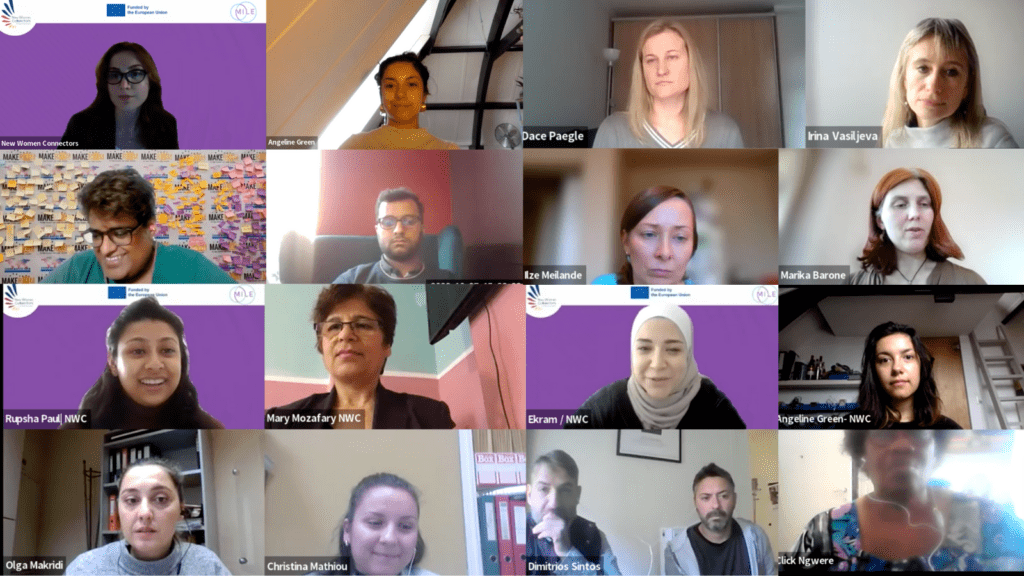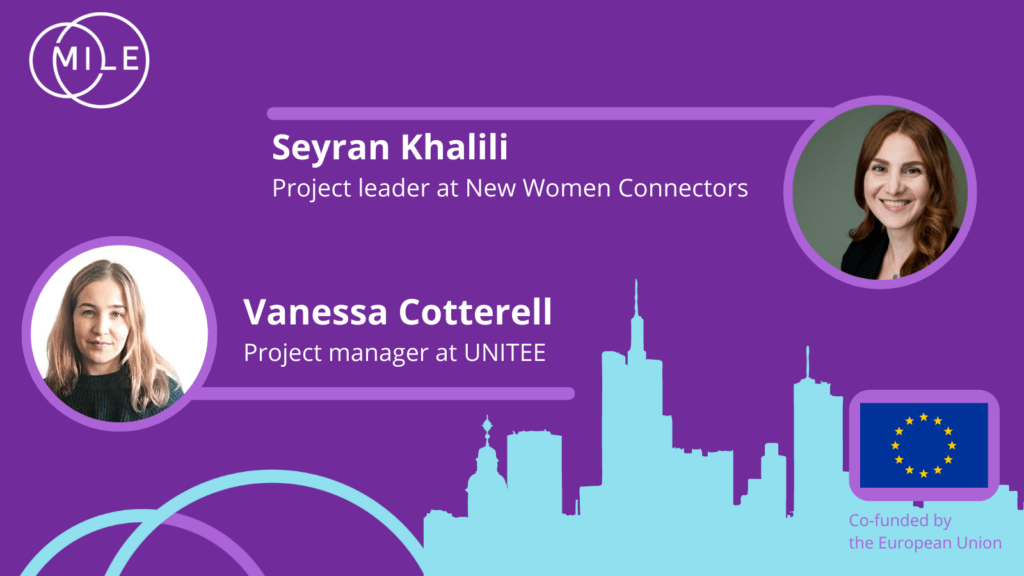This interview was conducted by Vanessa Cotterell (coordinator of MILE, UNITEE) with Seyran Khalili from New Women Connectors (NWC). NWC are faciliating the training for municipalities and migrant communities in the context of the MILE project. Seyran is an organisational psychologist working in the field of inclusion and social justice. She is active in civil society as a youth advocate working on empowering refugee and migrant youth with inclusion in civic space through the project Young Connectors at New Women Connectors. Her work in civil society revolves around creating a generation of young people who can be supported to interact with decision-makers and be the voice of the youth of their communities.
The next training will take place on 15 and 16 December. More information can be found here.
What is the MILE training about and what can participants learn?
Seyran K., NWC: The training is about creating a better understanding of each other. It is about meaningful participation, but also about trying approaches that put citizens at the core of a city’s services and local policy-making. When we designed the trainings together with members of migrant communities and municipalities, the idea was to create a space to talk together and to better understand each other. The training is organised both for migrant communities and municipalities (including local service designers, advisors and colleagues from the municipality’s outreach department) but from different angles. The experience of the participants is not of relevance.
The training for municipalities
In the training for municipalities it is a lot about how local policy-makers can rethink the role of citizens and residents in a city. The training can also help a city council to adjust their internal processes by making use of diversity management and intercultural understanding. During the training, participants are asked to depict different migrant backgrounds, imagine various intercultural experiences of citizens and react through empathy and compassion to come to a better understanding of migrants’ needs resulting in more effective policies.
A big part of the training for municipalities is therefore also about defining and truly understanding different migrant profiles and the needs and milestones behind that person’s journey and reality. For this, we also rely on ‘case studies’, that help us challenge the norm and how we view migrants. The training also draws from some newer methodologies such as theories based on design-thinking and the designed subject, i.e. how the municipalities and local services can cater to the needs of the diverse city population.

The training for migrant and refugee advocates
For the migrant community, the training is partially the same as the one for municipalities. The group also defines together who is a migrant and what the migrant’s journey can look like, but from their own perspective and their context. Moreover, they discuss the policy cycle and how migrants can participate in the various steps of the policy-making process at the local level.
Questions we aim to explore during the training may include:
- How can we do advocacy work together when we are working on different causes?
- What are the services migrants can expect from a municipality?
- And how can migrants connect with the people designing the services?

The first training sessions took place in November and where held separately for municipality and migrant community representative in each of the partnering countries (Greece, UK, Spain, Latvia). The objective of the training was to firstly examine what the cities have been doing so far to promote the participation of their migrant population and reflect critically on where that fits in the participation ladder. We went through different case studies of innovative approaches that some cities have already implemented to promote the meaningful participation of migrant communities. We also explored innovative concepts such as design thinking, co-design, service design and how they relate to innovation processes within the public sector.
The learning goals of the first training:
- to reflect on the current processes on involving migrants in decision making;
- to provide inspiration through case studies and best practices from different cities;
- to showcase innovative approaches and promotion of innovation culture in integration strategies.
The second training was more about connecting the dots between cities and migrants’ perspective. It was about them having a space to talk to each other, creating connections and spaces for collaboration. Here, we sort of matched the journeys, challenges and priorities by comparing migrants’ and municipalities’ perspectives to see whether we are actually seeing the same picture and where the different views can complement and help each other.
The last and third MILE training, held online on 15 and 16 December will connect the four MILE municipalities on the one hand, and the migrant groups in the different countries on the other hand, for a session on peer learning and best practices for stakeholder engagement.
With the municipalities, we will also look at the sustainability of the consultative migrant bodies they will set up in 2023 as well as benchmarks for co-design (how will the municipalities manage the consultative body? How are they going to ensure its sustainability? How will they work towards ensuring real representation of migrant groups?). After the final training, municipalities will be assigned a task to develop a plan on how they can sustain the consultative body after the end of the MILE project.
With the migrant communities we will focus on migrant and refugee leadership and advocacy and peer learning. Participants will work on a community-building canvas to promote meaningful participation within organisations that work on migrant and refugee advocacy. For this training, we will also provide guidance on community leadership and advocacy tools.
Can you give some more examples of exercises and ways you apply the methodology in the training?
Seyran K., NWC: All of the training sessions are activity-based so it’s very interactive from the start. We have planned for a bit of theory but a lot of the content actually comes from the training sessions themselves, as each training is built on the feedback and priorities of the participants. An example of an exercise we use is journey mapping, a methodology coming from service design. Another one is where we actually show case studies on the basis of which we let participants reflect, ultimately to understand: What does a certain situation mean from the migrant community’s perspective and from the municipality’s perspective and how can this be translated into my local context?

How has the training been received so far and what was your impression of the experiences and interactions of participants?
Seyran K., NWC: I joined most of the trainings and the groups have been very diverse. There are also diverse contexts. Some do have experience with the methodology but for others, it’s very new. We see that many of the participants are used to talking about their challenges and are eager to jump into the part about the solutions. But when we are talking about designing local experiences and policies, it is crucial that we take a step back to always understand the bigger picture first, by mapping of needs of citizens to really understand what policy-makers are designing and for whom.
Progress can feel slow at the beginning because the experience of migrants is often: “We have talked about this in the past, but who is listening to us?” But this is part of a systematic approach that we use and by which we map needs from both perspectives – the migrants and the municipalities – and by having this approach we will be able to see a very clear map in the end through which we can take knowledge-based decisions.
How can these trainings prepare for the next activities planned within MILE in 2023 such as the consultative migrant bodies and the European exchange platforms for migrants and local policy-makers?
Seyran K., NWC: The training are still ongoing and we try and connect the different sessions by sending participants homework or reflection exercises they can work on before the next session. This way we also hope to keep the knowledge fresh. A take-away would be for participants to know the ‘train the trainer approach’, so they can take back these tools and use it in their own context and share with others. For example, we always share the results from the ‘jamboards’ (digital interactive whiteboards). We use these jamboards to visualise participants’ thoughts and ideas and in the end, we can produce a sort of toolbox of the tools that they can take back and reuse again.
I believe the key lies in the potential of these trainings to encourage a development process for municipalities, migrant communities and other local stakeholders to learn and co-create policies together, built on mutual trust and find a way for participation tools, like the consultative bodies, to become effective and sustainable. Ideally, the approaches we try to convey in the training become part of the daily activities of participants and are streamlined across policy and advocacy strategies. Hopefully the training can also contribute to building trust and commitment, encourage the further development of transparent participation tools adapted to their local context but also a promote listening and mutual understanding in local communities.


